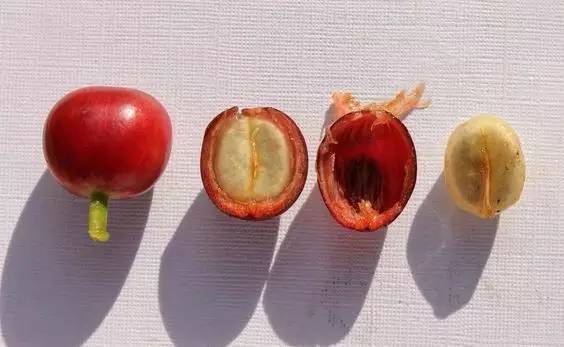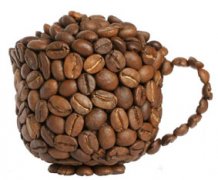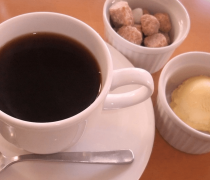Coffee knowledge | Classification and characteristics of common coffee beans

For professional baristas, please follow the coffee workshop (Wechat official account cafe_style)
[about coffee beans]
What is available on the market is coffee in three forms: raw beans, cooked beans and coffee powder. It is recommended that you buy coffee cooked beans, and the fresher the better, because raw beans need to be roasted to change their taste before they can be eaten, but after baking, various flavors will disappear with the volatilization of moisture and carbon dioxide. So it is recommended that you buy freshly roasted coffee beans, and do not buy too many coffee beans for about a month at a time.
[coffee classification]
Variety:
There are four kinds of coffee trees in the world, and the coffee we drink now is mainly the fruit of two kinds of coffee trees, one is Arabica, the other is Robasta. Arabica coffee trees are not easy to grow, many are on high-altitude slopes, and picking needs to be done manually, but they have a balanced, high-quality taste and less caffeine. Robasta is easier to grow. All kinds of coffee are heat-resistant, cold-resistant, moisture-resistant, drought-resistant and disease-resistant. It was because of leaf rust that coffee in Vietnam was changed to Robasta because of the death of Arabica coffee trees. In addition, Rothbata is also easy to harvest, artificial external vibration machine can also be competent, but the coffee beans produced are poor aroma, bitterness and acidity, and high caffeine content. So it is mostly used to make instant coffee. Now most of the beans on the market are grown in Arabica.
Taste:
When you buy coffee beans, you will see descriptions of different coffee flavors, using adjectives such as tropical fruit, caramel, nuts, cocoa and so on. These descriptions of coffee flavor are all derived from the coffee flavor wheel produced by SCAA (Specialty Coffee Association of America).
[characteristics of various coffee beans]
◎ Manning
The southern part of Sumatra, Indonesia, has relatively high alcohol thickness, obvious bitterness, low acidity and deep baking degree.
Grading: according to the quality of defective beans, from Grade1 (G1) to Grade6 (G6), the quality is divided into 7 grades, and G1 is the best. In particular, I would like to mention Gold Manning, different from the usual understanding, Huang Man is not a grading standard, but PWN selected full-grained, larger-sized beans, named Golden Manning, and registered trademark. So strictly speaking, only beans produced by PWN can be called golden manning, and other beans of the same or better quality can not be called golden manning.
◎ Yega Xuefei
The Sidamo region, which mentions Yega Chuefei, describes it as "strong floral aromas, subtle fruit acidity, soft bergamot and lemon flavors", with a hint of floral and fruity aromas, slightly sour on the palate, and it is good to like the layers of this sour Yega Chefe coffee.
Grading: Yega Xuefei's grading system is a little confused. According to the treatment method, it was first divided into water washing: G1, G2 according to SCAA, and sunlight: G1, G3, G4, G5 (no G2), the smaller the number, the higher the grade. But it seems that since a few years ago, Ethiopian officials have developed another set of grades, with all exported coffee beans anonymously concentrated on the Ethiopian Commodity Exchange (ECX). High-quality beans were divided into An and B groups, and each group was subdivided into 1 and 2 grades. Group An is Yega Xuefei, which means that high-quality Yega Chuefei beans are grade A1. This anonymous approach makes it difficult for us to trace specific farms. At present, some domestic sellers are still using the old G1, G2 classification standards, and some are using the new A1, A2 system.
◎ Blue Mountain
The most famous coffee in the country is Blue Mountain Coffee. Blue Mountain Coffee is produced in the Blue Mountains near Kingston, the capital of Jamaica. because of its small production and monopolized by Japan, the quantity of Blue Mountain coffee to other countries is very small, which keeps the price high. In the early years, due to plumbing problems, there were few authentic blue mountain coffee in China, only "blue mountain flavor coffee". To say that the most important feature of Blue Mountain coffee is the balance of various flavors, but those who like it like it, while those who do not like it regard it as boring and think that the greatest feature of Blue Mountain is that it has no characteristics.
Classification: the classification of Blue Mountains, from high to low, is divided into Blue Mountains No.1, No.2, No.3 and Blue Mountains mixed. And the special blue mountain round bean (PB). In addition to Blue Mountain Coffee, coffee grades in other Jamaican producing areas are also classified from high to low: Alpine Coffee, Jamaican quality and Jamaica selection.
◎ Hawaii KONA
"due to the island topography and volcanic soil, Hawaiian coffee has a very special taste, not too strong, not too sour and mellow, with pleasant wine aromas and acidity.
Classification: KONA coffee is divided into four grades, which are the most advanced Extra Fancy, Fancy, Prime and Gr. No.1 et al. However, due to low production and high production costs, with the increasing demand for boutique coffee in recent years, the price of Kona on the market is catching up with the Blue Mountain of Jamaica, and it is becoming more and more difficult to buy good Kona beans.
◎ Rose Summer
Rosa rugosa is a new variety in recent years, which has been planted in many parts of the world, with high quality in Panama, Guatemala, Colombia and other Latin American countries. Now its reputation and price are catching up with Blue Mountain and KONA. The flavor is mainly fruity and an aroma similar to oolong tea, so some people say that there is a feeling of drinking herbal tea when drinking rose summer.
◎ Brazil
Brazil is the largest coffee producer in the world, with the largest total output in the world. Coffee taste mild, slightly sour, slightly bitter, no major shortcomings, no outstanding advantages, relatively moderate, so there is not much boutique coffee, mainly used as beans.
◎ Colombia
The second largest producer of Colombian coffee. Although its output is lower than that of Brazil, the overall quality of coffee beans is higher. The greatest feeling of Colombian coffee should be smooth, this kind of coffee is medium mellow, low acidity, sweet taste, with some nutty flavor, suitable for medium or deep roasting, drink alone, with beans are good.
◎ Kenya AA
Obvious fruit aroma and acidity, sour taste is different from the bright acidity of Yegashifi, Kenyan acid is more rugged.
Grading: AA is actually a grade of Kenyan coffee, with AA++ and AA+ above it, AB below, and PB round beans. However, at present, Kenyan coffee is collectively referred to as Kenya AA in China.
◎ Antigua, Guatemala
Antigua coffee is produced in Antigua, because it is grown on the hillside of the hinterland of the volcano, the beans will contain nitrogen, and it will be charcoal or smoky after baking, but this flavor has a lot to do with the depth of baking. like medium baking, it's hard to show.
◎ Costa Rica
The most famous is the Tarasu producing area. Due to the strict control of the local government, the quality of raw beans is good, but there are few defective beans. Planting at high altitude has a strong sour taste, and coffee trees grow slowly because of the lower temperature in the mountain area, with a more complex but not monotonous taste.
Important Notice :
前街咖啡 FrontStreet Coffee has moved to new addredd:
FrontStreet Coffee Address: 315,Donghua East Road,GuangZhou
Tel:020 38364473
- Prev

Want to drink coffee, but have heart palpitations? You need to know the different ways of cooking.
Professional barista communication Please pay attention to the coffee workshop (Wechat official account cafe_style) many people like to drink coffee, but there are also many people like to drink but can not drink, because after drinking heart palpitations. There are many theories about the causes of heart palpitations when drinking coffee: * you drink rotten and stale beans. * you drink the general cheap coffee variety beans, called Robusta Robusta, this
- Next

Is the black coffee good? How to choose coffee, single bean or formula bean?
Communication of professional baristas Please follow the coffee workshop (Wechat official account cafe_style) Coffee formula beans or individual beans are better? Generally speaking, coffee has a variety of charming charm, delicious and their own preferences have something to do with, so it is important to understand the characteristics of coffee. Individual coffee can best show the unique producing area personality of coffee beans, due to the different regions of the country.
Related
- What is the difference between a cake filter cup and a V60 conical filter cup? What are the advantages and disadvantages of the flat-bottomed filter cup brewing solution?
- What is the difference between fine coffee powder and medium coarse coffee powder? Do I need to sift out the fine coffee powder for making coffee by hand?
- Why does hot American coffee taste bitter? Difference in proportional concentration between hot American and ice American
- Is espresso stored overnight in the refrigerator harmful to your body? Is frozen coffee better than freshly ground coffee?
- What parameters and proportions of water temperature should be used to grind and brew fresh coffee beans? Why can't I drink freshly roasted coffee right away?
- Customers have "changed" Manner's new products! Shop assistant: Please don't mess around!
- Remove sockets in customer areas at Starbucks stores?! Netizen: I won't go if I really tear it down
- What is the difference between the taste steps of sun-dried coffee and washed coffee? Why is sun-cured coffee sweeter and washed coffee sour?
- The recipe for salty grapefruit dirty is revealed! Coffee Festival salty grapefruit dirty coffee making materials parameters ratio milk share!
- How about the flavor of Sunlight 74158 at Sidamo Banshaha Mathieu Processing Factory in Ethiopia? 74158 Share the proportion of coffee brewing parameters!

